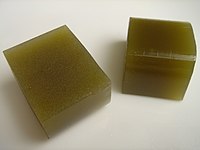
Photo from wikipedia
Chemotaxis of enzymes in response to gradients in the concentration of their substrate has been widely reported in recent experiments, but a basic understanding of the process is still lacking.… Click to show full abstract
Chemotaxis of enzymes in response to gradients in the concentration of their substrate has been widely reported in recent experiments, but a basic understanding of the process is still lacking. Here, we develop a microscopic theory for chemotaxis that is valid for enzymes and other small molecules. Our theory includes both nonspecific interactions between enzyme and substrate as well as complex formation through specific binding between the enzyme and the substrate. We find that two distinct mechanisms contribute to enzyme chemotaxis: a diffusiophoretic mechanism due to the nonspecific interactions and a new type of mechanism due to binding-induced changes in the diffusion coefficient of the enzyme. The latter chemotactic mechanism points toward lower substrate concentration if the substrate enhances enzyme diffusion and toward higher substrate concentration if the substrate inhibits enzyme diffusion. For a typical enzyme, attractive phoresis and binding-induced enhanced diffusion will compete against each other. We find that phoresis dominates above a critical substrate concentration, whereas binding-induced enhanced diffusion dominates for low substrate concentration. Our results resolve an apparent contradiction regarding the direction of urease chemotaxis observed in experiments and, in general, clarify the relation between the enhanced diffusion and the chemotaxis of enzymes. Finally, we show that the competition between the two distinct chemotactic mechanisms may be used to engineer nanomachines that move toward or away from regions with a specific substrate concentration.
Journal Title: Nano letters
Year Published: 2018
Link to full text (if available)
Share on Social Media: Sign Up to like & get
recommendations!